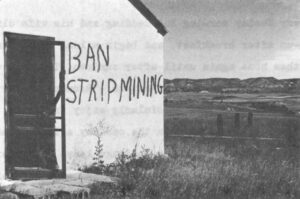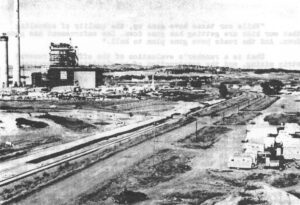One of the most appealing of all alternate energy sources is the wind. The wind is immediately available, and readily convertible: unlike fossil fuels, it does not require millions of years of processing, and refinement. The wind is not based upon a non-renewable energy source, as is nuclear power. Solar energy — a category to which wind belongs — is constant and abundant and the wind is one of the more easily utilized aspects of the sun’s power.
The joint committee of the National Science Foundation and the National Aeronautics and Space Administration has suggested that by the year 2000, a serious development program in wind power could produce 1.5 trillion kilowatt hours a ear of electricity — almost the total amount of electricity consumed yearly In the United States up until the last few years.
That prediction is termed self-fulfilling by one of the foremost authorities in wind power in this country, William E. Heronemus, professor of civil engineering and aerodynamics at the University of Massachusetts, Heronemus has almost single-handedly taken on the utilities and other vested interests opposed to full-scale development of wind power in New England.
Heronemus claims that by relegating practical wind power to the twenty-first century we can excuse the relatively small percentage of alternate energy research funds that have been assigned to the development of wind power, He believes that with proper funding, wind power could prove highly practical long before the end of this century.
Heronemus is attempting to revive Interest in wind power for several reasons. Wind is available in quantities capable of having a-major impact on the total energy demand of the United States. There already exists a highly developed technological base in aerodynamics that could be significantly expanded through research into specific energy needs. Also, wind contains no pollution, and could produce — economically — hydrogen gas for storage, transmission, and combustion.
The ambitions proposal for which Heronemus is best known is the creation of the New England Offshore Wind Power System (OWPS), He believes such a system could provide all the electricity — peak demand and continuous load — for the six New England states by 1990. The system would be located one hundred miles offshore, over Georges Banks in the prevailing westerlies above the continental shelf.
The wind stations themselves would have maximum capacities of six megawatts with various types of wind generator arrays, Sea water could be distilled and electrolyzed at the sites, and hydrogen gas stored in pressurized tanks on the sea bed, It could then be pumped ashore on demand, and distributed by pipelines.
One re-conversion system known as the Northeast Utilities Fuel Cell Mini Substation concept would use hydrogen and air to generate electricity locally. Research has been conducted, based upon existing technology that indicates the average revenue required per kilowatt-hour would be thirty-five mills, cheaper than the present rate.
Heronemus first proposed the wide-ranging network of wind generators in 1970, before the energy crisis. The wind power station he suggested placing off Long Island was to be a substitute for the nuclear power plant scheduled for construction in Shoreham, New York.
The wind stations would be mounted either on large, semi-submersible platforms, or placed in relatively shallow water. Each station would support three wind towers, each of which would support two 200-foot diameter wind turbines. Six hundred and forty wind stations would be linked together along sixteen lines extending north and south. Heronemus points out that the loss of a-single generator would not cripple the entire system because of its decentralized nature an important consideration that could prevent blackouts of large areas.
“One wind station disabled ” says Heronemus, “would mean one thirteen-thousandth of the system capacity would be lost.”
Researchers at the University of Massachusetts have also proposed other wind power systems for generation of electricity to serve the Lake Ontario region for New York Shoals, and for the Prairie states. These studies supposedly show that enough electricity could be generated by wind to make the cost competitive with fossil-fueled electrical generation.
There is a catch, however, to large-scale wind power systems. The wind is much stronger several hundred feet above the surface of the earth than it is within one hundred feet of the surface. Most wind generators would therefore have to be located at least three hundred feet above ground. The prospect of huge electric generators towering over the countryside is not necessarily a pleasant one, and could be hazardous as well as a kind of visual pollution.
Heronemus’ idea for wind power is not now, During World War II, a huge 1,250-kilowatt wind electrical station was operated in the mountains of central Vermont, at a place called Grandpa’s Knob. It produced electricity for almost a year and a half, before a main bearing in the generator failed, It could not be replaced because of wartime shortages, and for two years the blades of the generator were locked in place, subjected to continuous winds. The bearing was finally replaced, but not before stress had weakened the spars of the eight-ton blades, causing one to break. The station was never repaired.
Wind has served as a source of mechanical power for centuries. Holland became the wealthiest of western nations during the mid-seventeenth century largely through the use of wind power for manufacturing on shore, and for driving its merchant fleet. The popularity of wind as a source of power grew steadily, until cheap petroleum fuel and cheap internal combustion engines replaced the more expensive windmills, and national electrification schemes — such as the United States’s Rural Electrification Administration — began to provide cheap electricity for even the most isolated areas.
But around the middle of the nineteenth century, windmills in America produced almost one-and-a-half billion horsepower-hours of work a year — the equivalent of burning million tons of coal. By 1870, the amount of produced here by windmills had been halved. The steam engine, also dependent upon fossil fuels, had made the difference.
The windmill industry in America, however, prospered well into the twentieth century. Wind-powered electric generators were developed during the 1920s and it took Roosevelt’s REA program to kill that industry. Later, the windmills seen across the American plains were used only for pumping water.
Two important wind power programs were developed later. The Smith Putnam Project of 1939-1945, and the Percy Thomas Project of 1944-1951 demonstrated the abundant technology of large-scale wind power projects. But by that time it was too late to Interest either the private sector or the federal government in the application of that technology.
Fossil fuel was cheap and wind power simply could not compete. Environmental concerns were minimal, and few Americans cared about pollution-free energy, or the depletion of resources. Then in the 1950s experts promised that nuclear energy would soon be produced that would be “too cheap to meter.” Wind technology was all but abandoned.
One question asked during any discussion of wind power is what happens when the wind stops blowing? Proponents of wind generators have more answers today than they did twenty years ago. Wind can charge batteries in a small wind power plant, thereby storing the energy.
In a large system providing enough electricity for wide transmission energy can be stored mechanically by pumping water or air into a reservoir and then releasing the water or air to drive a turbine that operates an electric generator. The flywheel is another storage device. Driven by the blades of a wind generator but stepped up to a greatly increased RPM, the flywheel can be used to generate electricity as it runs down, long after the wind has ceased. Some experts claim that a properly designed flywheel enclosed in a vacuum chamber is cheaper and more efficient than a storage battery.
Some researchers have suggested that the problem of storing energy could be avoided altogether by linking wind plants to a regional utilities grid. By picking certain areas of the country where the wind is strong and relatively constant, a power bass could be established. On those days when no wind energy mould be fed into the grid, fossil fuel power could be used as a supplement.
Transmission of electricity is one of the greatest cost factors in energy development. Wind is freely distributed across the face of the earth, without the expensive transport systems needed for fossil-fueled energy transmission. Small scale, Individual use of wind power could eliminate much-of that cost. Water-pumping windmills are an obvious example. The Brace Research Institute at McGill University in Montreal, a leading center for research into natural energy sources, has developed many designs for windmills, one of them for the small landowner that utilizes two 45-gallon oil drums cut lengthwise and welded together to form troughs that scoop up the wind. A group of communards in Wisconsin has also designed several small wind plants — one based upon a design by Buckminster Fuller — and some can be constructed for as little as $200.
Now it is generally accepted that the design of wind power plants with capacities ranging up to one hundred kilowatts no longer present fundamental technological problems. Considering the potential of the wind as a renewable energy source, it is unfortunate that more funds have not been diverted into wind research, and that private industry is so reluctant to work toward the development of commercially attractive systems for producing wind power.
Interest in the wind as a source of motive power has also been renewed. Wilson Clark has written in Smithsonian Magazine about a proposal for a fleet of “Dyna-Ships” being developed at the School of Naval Architecture at the University of Hamburg. They are modernized four-masted clipper ships with sails that extend from the center of two-hundred-foot masts on curved steel yardarms, and can be trimmed by remote control from the bridge.
Tests have shown that winds in the North Atlantic would propel the Dyna-Ships up to speeds of twenty knots approximately seventy-two per cent of the time. Auxiliary engines could be used for windless conditions, and for maneuvering. Such a ship — at about seventeen thousand tons — would consume only five per cent of the fuel required by a modern freighter.
The greatest interest in wind power is shared by individual Americans looking for an alternate method of providing electricity for their homes. Wind and solar heat have been successfully incorporated in a year-round home near Albuquerque New Mexico built by Robert Raines. His Prototype I is a dome heated by solar energy and electric power for the usual appliances is provided by the wind. Reines first installed his wind generator in the winter of 1972, and then devoted months to rebuilding used wind generators, and constructing his solar heat collector. His home took ten months to build, and cost about $12,000.
A consulting firm in Cambridge, Massachusetts, reports that a survey conducted recently indicated a market in the United States of $1.3 billion by 1985 for solar heating and cooling systems and wind power plants. The interest was reflected in the participation in the first International Solar Industry Expo, which this year drew six hundred participants, and more than thirty exhibitors.
The only commercial distributor of home-size electric wind generators In this country is the Solar Wind Company of East Holden, Maine, Founded by Henry Clews the Solar Wind Company has in the last year and a half received 35,000 letters from people interested in installing wind power systems in their homes, or in second homes.
“These letters come from all stratas of society,” says a spokesman, “They’re not just hippies going back to the land, they’re doctors, lawyers, farmers.”
Until recently, Solar Wind sold Australian and Swiss wind generators, but now deals only In American equipment. One system, called the Windcharger, is a twelve-volt generating apparatus that produces two hundred watts, and costs $400. A larger twelve-volt model from California, the Sencenbaugh, produces seven hundred and fifty watts, and costs $1500, This model could meet the energy requirements of a household willing to budget on power — to do away with hair and clothes driers, and to limit the running of electrical appliances, and the burning of many lights at the same time.
“The problem today is that there just isn’t the right kind of equipment available to do all the things in the home that Americans have become accustomed to.”
A wind power system able to provide sufficient electricity for a large American family accustomed to unlimited use would require probably two imported systems costing about $15,000 apiece Including the tower, wind generator, inverters, and batteries.
Wind power is just one aspect of the more general category of solar power. Each year the sun provides about 18,000 times the amount of energy needed to meet the world’s requirements. As the sun’s heat approaches the earth it creates wind, and in warming the surface makes possible the cycle of life, Interest in solar heat and wind power demonstrated by the federal government is beginning to also Interest private industry.
The Solar Heating and Cooling Demonstration Act passed by Congress enabled the National Aeronautics and Space Administration and the Department of Housing and Urban Development to begin work on many programs for the practical use of solar heat in private and commercial buildings. The value of such technology is to be demonstrated within three years and combined heating and cooling systems are to be developed within five years.
Another source of alternate energy being studied is bioconversion — the heating of plant products in a vacuum to produce gas. It is an artificial acceleration of the process of producing fossil fuels. Bioconversion promises to become economically feasible as an energy source within the foreseeable future. Several demonstration plants have been constructed in the United States the best known being the Union Electric Company’s plant in St. Louis that feeds burnable shredded wastes into a furnace along with coal.
The National Science Foundation contends that bioconversion could produce as much as eight per cent of the nation’s consumed energy by the year 2000.
But any use of alternate energy sources In America is going to require adaptation by Americans, As the spokesman for Solar Wind says, “Most people want to maintain their standard of living and have wind power at the same time. We’ve just got to be more realistic.”
Received in New York on July 21, 1975.
©1975 James Conaway
James Conaway, a freelance writer, is an Alicia Patterson Award winner. This article may be published with credit to Mr. Conaway and the Alicia Patterson Foundation,




